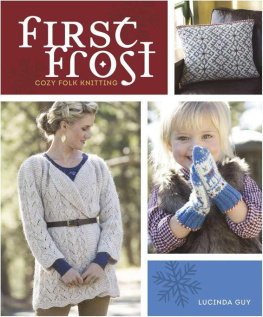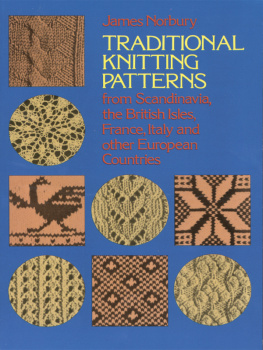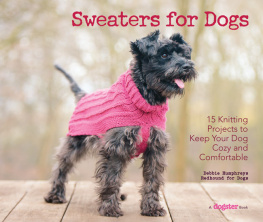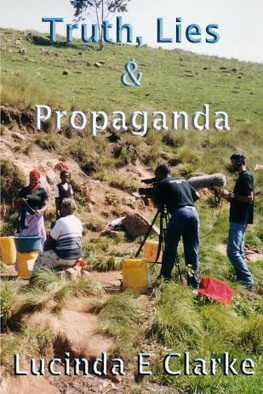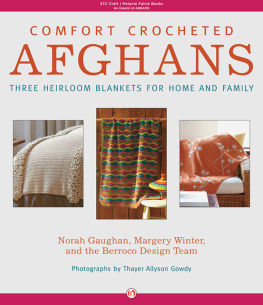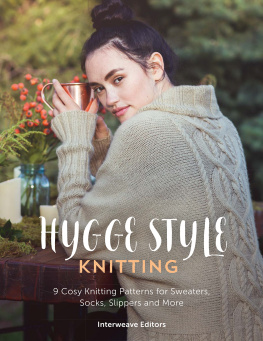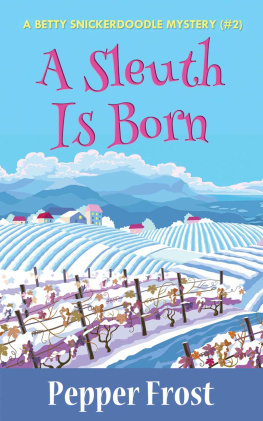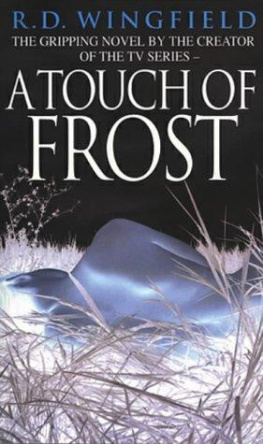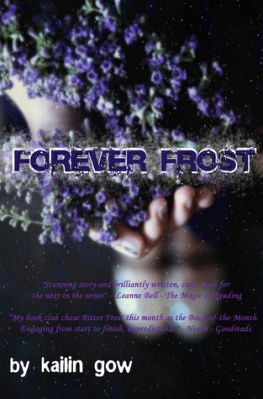Lucinda Guy - First Frost Cozy Folk Knitting
Here you can read online Lucinda Guy - First Frost Cozy Folk Knitting full text of the book (entire story) in english for free. Download pdf and epub, get meaning, cover and reviews about this ebook. year: 2014, publisher: Interweave, genre: Home and family. Description of the work, (preface) as well as reviews are available. Best literature library LitArk.com created for fans of good reading and offers a wide selection of genres:
Romance novel
Science fiction
Adventure
Detective
Science
History
Home and family
Prose
Art
Politics
Computer
Non-fiction
Religion
Business
Children
Humor
Choose a favorite category and find really read worthwhile books. Enjoy immersion in the world of imagination, feel the emotions of the characters or learn something new for yourself, make an fascinating discovery.
- Book:First Frost Cozy Folk Knitting
- Author:
- Publisher:Interweave
- Genre:
- Year:2014
- Rating:5 / 5
- Favourites:Add to favourites
- Your mark:
- 100
- 1
- 2
- 3
- 4
- 5
First Frost Cozy Folk Knitting: summary, description and annotation
We offer to read an annotation, description, summary or preface (depends on what the author of the book "First Frost Cozy Folk Knitting" wrote himself). If you haven't found the necessary information about the book — write in the comments, we will try to find it.
First Frost Cozy Folk Knitting — read online for free the complete book (whole text) full work
Below is the text of the book, divided by pages. System saving the place of the last page read, allows you to conveniently read the book "First Frost Cozy Folk Knitting" online for free, without having to search again every time where you left off. Put a bookmark, and you can go to the page where you finished reading at any time.
Font size:
Interval:
Bookmark:



First Frost: Cozy Folk Knitting is a celebration of that certain time of the year when nights become longer, darker, and colder and dawn brings a bright, clear, and frosty morning. The seasons shift, summer has long gone, and there is a definite chill in the air. It is a time when you feel the need to light a fire in the fireplace and cheerful candles on your table, and reach for cozy woolen knits to wrap up in.
This collection also celebrates all that is wonderful about the construction of decorative folk knitting, in particular the construction of folk mittens, folk gloves, and folk socks. As essential everyday items for anyone living and working in the harsh, cold climates of the North, these folk knits could range from the simple and utilitarian to exuberantly textural, braided, tasseled, colored, and patterned knits traditionally reserved for special occasions and celebrations. These intriguing and beautifully decorative knitting techniques have served as inspiration for the twenty cozy and comforting designs in this book.
In traditional decorative Northern European folk knitting, a single pair of socks or mittens could easily have as many as ten, possibly more, individual folk motifs contained within its designs, and these garments were often further decorated with colorful fringing, tassels, and tufts.
What better way is there to celebrate these old and often ancient folk techniques than by continuing to incorporate them into our everyday knits? As you work your way through the patterns in this book you will become familiar with these fantastic techniques; and from that point on, whenever you decide to knit a pair of socks, you will know how to enhance them with various embellishments: bands of patterns, a knotted decorative cast-on, a tassel, or specific shaping at the toe. Every pair of mittens or gloves you knit could have a colorful, braided cast-on, colorful textural details, and patterns.
I hope you enjoy making and wearing these beautiful knits!
Lucinda Guy

Tapio, the ancient protective Finnish forest spirit, was believed to have hair of lichen, eyebrows of moss, and a mossy green cloak. When asked, Tapio would benevolently grant safe journey through his forests.

The typical Nordic, Baltic, or Scandinavian folk palette consists of colors that were considered to be protective, symbolic, and important. Northern peasant life traditionally revolved around seasonal celebrations of growing and producing food; the colors considered highly significant and representative of nature and renewal were used prolifically: berry reds, natural white, bright sky blues, golden corn yellow, fresh leafy greens, and forest greens.
The most popular of these color combinations is red and white. Red was thought to symbolize the sun, fire, youth, and life, and white was associated with purity. When used in combination, red and white were considered portentous and were important for ritual celebrations such as marriage.
The natural tones of sheeps wool were used in combination with dyed yarn. Moss, bark, leaves, berries, lichens, and toadstools, readily available in the fields and forests, were used regularly for dyeing. In all of Northern folk art, woodlands and forests were held in great esteem by country people, and often closely associated with folklore and all things magical.
Over the past two hundred years chemical dyes that produce consistently clearer, brighter colors began to replace the local plant dyes, and distinct new color and pattern combinations emerged. These vibrant combinations are now universally associated with Northern folk knitwear.

Beautiful examples of folk socks and stockings can often be found in museums. These gorgeous garments can range from elegant one-colored Swedish twined stockings to elaborately patterned and colored Fair Isle socks. It is the riotously patterned and exuberantly colored knitted Estonian stockings from the Estonian island of Muhu that I turned to for reference for these socks.
The Tka socks have been knitted in the round with 5 double-pointed needles from the top down using a traditional Estonian cast-on, colored rib patterning, and several bands of Estonian patterns. These have been embellished with duplicate stitches and French knots. There is a single flower motif on the foot to demonstrate the clever technique of knitting single areas of pattern in the round, and the toe is shaped using the distinctive Estonian toe shaping technique.
Traditionally, Estonian heels would have been knitted after the sock was completed, but I have designed the Tka socks with a turned heel and shaped gusset.

812" (21.5 cm) foot circumference and 1034" (27.5 cm) long.
Sock weight (#1 Super Fine).
Shown here: Cascade Heritage Sock Yarn (75% superwash merino wool, 25% nylon; 437 yd [399 m]/100 g): #5628 Cotton Candy (A), #5646 Pumpkin (B), #5606 Burgundy (C), #5612 Moss (D), 1 skein each.
Set of 5 size U.S. 2 (2.75 mm) double-pointed (dpn).
Adjust needle size if necessary to obtain the correct gauge.
Markers (m); waste yarn; tapestry needle.
30 sts and 42 rnds = 4" (10 cm) in St st worked in rounds, after washing.

With 1 strand of A and 2 strands of B, use the Knotted Cast-On method (see ), CO 75 sts76 sts, including the slipknot. Cut yarns, leaving long tails to use for braided cord. Divide sts over 4 dpn with 21 sts on Needle 1, 20 sts each on Needles 2 and 3, and 15 sts on Needle 4. Sl last st on Needle 1 to Needle 4, pass last st CO over the slipped st and off needle 75 sts. Place marker (pm) and join for working in rnds.
Font size:
Interval:
Bookmark:
Similar books «First Frost Cozy Folk Knitting»
Look at similar books to First Frost Cozy Folk Knitting. We have selected literature similar in name and meaning in the hope of providing readers with more options to find new, interesting, not yet read works.
Discussion, reviews of the book First Frost Cozy Folk Knitting and just readers' own opinions. Leave your comments, write what you think about the work, its meaning or the main characters. Specify what exactly you liked and what you didn't like, and why you think so.

